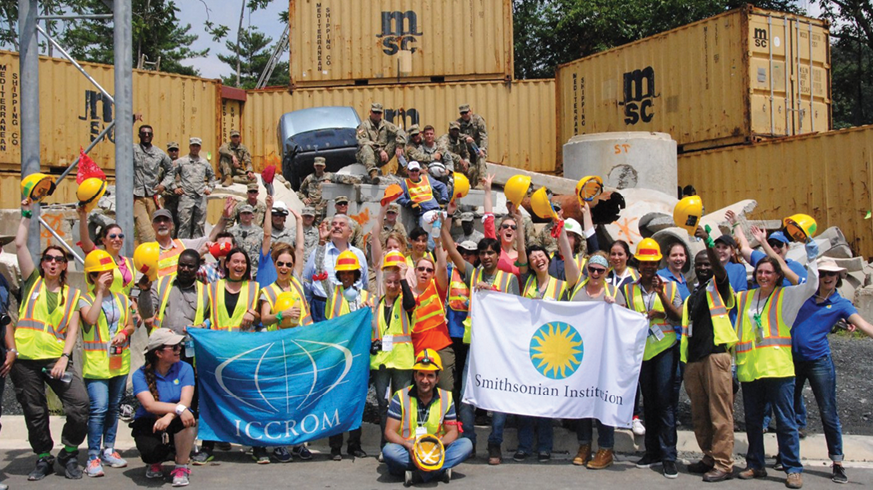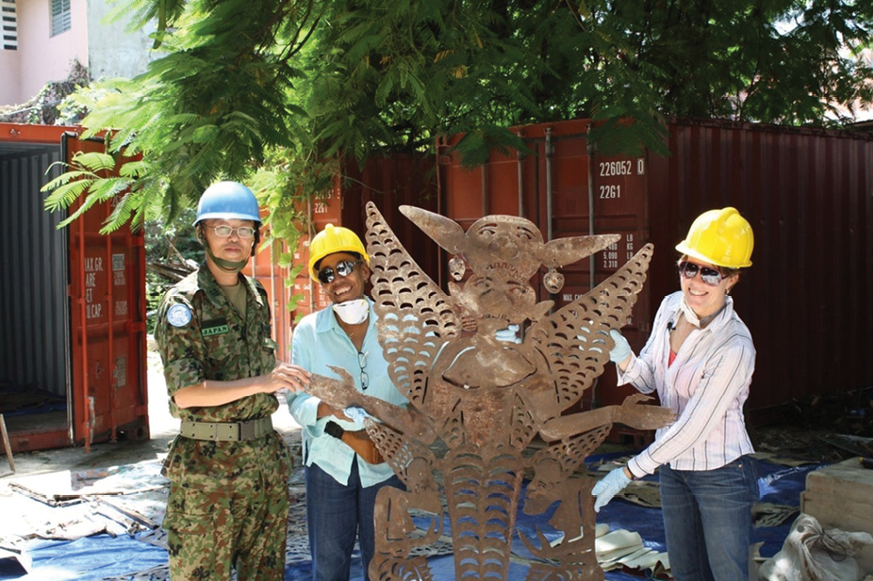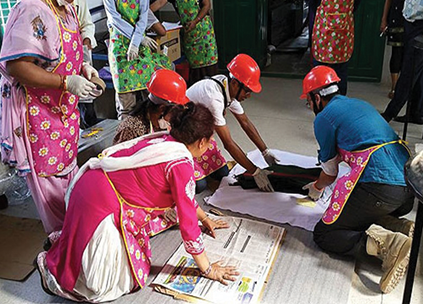- Home
- Media Kit
- Current Issue
- Past Issues
- Ad Specs-Submission
- Ad Print Settings
- Reprints (PDF)
- Photo Specifications (PDF)
- Contact Us

![]()
ONLINE

Culture and Resilience
Editors’ Note
Richard Kurin is the Smithsonian Distinguished Scholar and Ambassador-at-Large. As a member of the Smithsonian’s senior leadership team, Kurin focuses on strategic direction, institutional partnerships, public representation, philanthropic support and special initiatives. Prior to his current role, Kurin served as Acting Provost and Under Secretary for Museums and Research from 2015, and from 2007 as Under Secretary for History, Art, and Culture. During the preceding two decades, he directed the Smithsonian Center for Folklife and Cultural Heritage with its annual Folklife Festival on the National Mall and the Grammy-winning Smithsonian Folkways Recordings. He also produced major national celebration events associated with the opening of museums and monuments, presidential inaugurals and the Atlanta Olympics. Kurin served on the U.S. National Commission for UNESCO and helped draft an international treaty, now ratified by 170 nations, to safeguard living cultural heritage. He led efforts to save heritage in Haiti after the 2010 earthquake and has overseen projects for saving heritage endangered by natural disaster in Nepal and the U.S., and by human conflict in Mali, Egypt, Iraq and Syria. Kurin serves as Smithsonian liaison to the U.S. President’s Committee for the Arts and the Humanities and the White House Historical Association, and is a member of the U.S. Department of State Cultural Heritage Coordinating Committee. An anthropologist with a doctorate from the University of Chicago, Kurin specialized in the study of South Asia, conducting years of fieldwork in India and Pakistan. He has held Fulbright and Social Science Research Council fellowships, taught at the Johns Hopkins University School of Advanced International Studies, and authored six books, including Reflections of a Culture Broker: A View from the Smithsonian, Hope Diamond: The Legendary History of a Cursed Gem, and the best-selling Smithsonian’s History of America in 101 Objects. He has been honored by Harvard University’s Peabody Museum, the International Council of Museums, the American Anthropological Association, the American Folklore Society and the Cosmos Club. He is an elected fellow of the American Academy of the Arts and Sciences and a senior fellow at the Atlantic Council.
Institution Brief
The Smithsonian Institution (si.edu) is the world’s largest museum, education, and research complex, with 19 museums and the National Zoo – shaping the future by preserving our heritage, discovering new knowledge, and sharing our resources with the world. The Institution was founded in 1846 with funds from the Englishman James Smithson (1765–1829) according to his wishes “under the name of the Smithsonian Institution, an establishment for the increase and diffusion of knowledge.”

Smithsonian and international partners train cultural
first responders from around the world to save heritage
in disaster and conflict zones.
How do you define your role at the Smithsonian and what are your key areas of focus?
I have had numerous roles at the Smithsonian over the last four decades, from directing several national museums and programs to Under Secretary. Currently I concentrate on strategic direction, partnerships, philanthropic support and special projects like saving cultural heritage in the wake of disasters.
How do you describe your leadership style and what do you see as the keys to effective leadership?
I have long relied upon collaborative processes, the honest give and take of ideas among stakeholders, the need to provide ample room for creativity and risk-taking, and a focus on achieving results. I am a good listener and lifelong learner, and unafraid to carefully consider criticism and assessment by all involved and improve as need be.
“Culture is central to resilience, and its restoration in various tangible and intangible forms – such as buildings, performances, visual arts, literature, religious practice, culinary and media arts – helps regenerate and stabilize civic, economic and social life after major disasters and other traumas”

UN troops, Haitian and American conservators
rescue artistic treasures from the earthquake’s rubble
How do you define resilience?
In the natural world we think of resilience as the capability of environments, species and organisms to adapt and survive. For humans, it’s the same, but with an added measure of control over our future. We bring conscious deliberation, choice and motivation to bear in building reliance for individuals and groups. Simply, resilience is a means of keeping hope alive in the face of adversity.
Culture and resilience are inextricably linked. What is the role of culture in resilience and what is the role of resilience in culture?
Particular cultures give a flavor to how humans live and adapt as there are many different ways of doing things and succeeding, and the key actors may vary given diverse social structures and institutions. Fostering resilience in the Amazon rainforest and in Chicago are quite different. Building resilience in Lagos invokes different skills and considerations than in Vanuatu, so the tools and specific desired ends are culturally dependent. All extant cultures have been successfully resilient because they have survived and adapted over time. This typically occurs by building upon traditions through innovation and creativity, often spurred by cultural interchange with others. When cultures become too isolated, when they fail to innovate, or when the interchange with others is destructive, they die.
You have traveled the world helping preserve cultures. How has resilience factored into this work?
At the Smithsonian, we have been documenting cultures and aiding the survival of their languages, arts and knowledge systems for a very long time. More recently, we’ve mounted major efforts at preserving endangered heritage in the face of natural disasters and human conflicts such as saving Haitian material culture after the 2010 earthquake and saving Iraqi heritage in the wake of ISIS’ assault on museums, archaeological and historical sites. The affected populations – cultural professionals, artists and community members – have viewed these efforts as restoring history that was ripped away from them; as re-enforcing their sense of identity, value, and standing; and giving them spirit and hope at the most trying and challenging of times. Culture is central to resilience, and its restoration in various tangible and intangible forms – such as buildings, performances, visual arts, literature, religious practice, culinary and media arts – helps regenerate and stabilize civic, economic and social life after major disasters and other traumas.

Nepalese and Smithsonian conservators save
cultural treasures following the 2014 earthquake
As a cultural anthropologist living in these unprecedented times, how has your work changed as a result of COVID-19 and the anti-racist movement across the U.S. and the world?
The pandemic, racism and other ills isolate people and damage social cohesion. In the face of disease and fear, we have seen heroic efforts by the healthcare community to serve their fellow human beings. In the face of racial prejudice and mistreatment, we have seen folks – young and old, and of diverse backgrounds – on our city’s streets raising their voices to bring us together. So many people have been so creative in figuring out how to bring people together digitally, and though this is still at what I would consider an early stage, I’ve been moved by digitally united choruses, concerts and conferences, teachers using digital classrooms, and web-based visits, explorations, and discoveries. The crises are pushing us to invent new forms of social interaction.
Who are some of the resilient leaders you see today?
In the cultural fields, I see Yo-Yo Ma giving stirring digital performances to comfort people given their loss. LL Cool J has been a great public presence, putting out the message that we are all in this together. I see José Andrés mobilizing so many to appropriately feed needy bodies and souls. I’m proud of the role my colleagues have played. We tragically lost Congressman John Lewis recently, someone whose very life defined resilience. He inspired Lonnie Bunch, who was the leader of the national museum and is now the Secretary of the Smithsonian, who has through numerous appearances helped the nation better understand race in American History. In addition, professionals at our American Indian museum have helped foster greater respect for Native people in the face of denigrating stereotypes, and our biologists have continued their work in studying numerous zoonotic diseases and the transmission of viruses like the coronavirus so we are better prepared to deal with them in the future.![]()